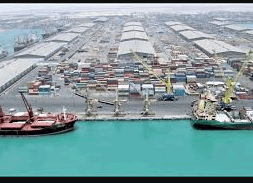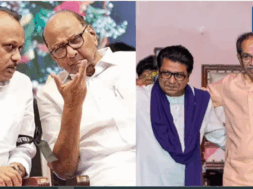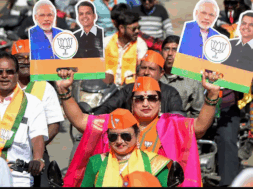
Roving Periscope: Bangladesh may return to seed, in (East) Pakistan!
Virendra Pandit
New Delhi: Many Pakistanis are celebrating the fall of the Hasina regime, believing they have avenged the split of 1971.
With all-around anarchy, mayhem, wanton arson, and bloodshed, a promising Bangladesh now resembles what it was until 1971: East Pakistan. Of course, (West) Pakistan also looks like going to seed—but Islamabad has the vicarious ‘satisfaction’ of being in the same pool as Dhaka.
The presidential election-bound United States has canceled her visa. The freshly Labour Party-led United Kingdom is reluctant to welcome her, given it is already fighting against anti-immigration and anti-Muslim demonstrators across the country which, for the first time, has elected 25 Islamist members to the House of Commons from Muslim-dominated constituencies—only in July.
France is also a difficult option, given the vulnerable, ongoing Olympic Games, the multiple Muslim-led immigrants’ agitations, and the upcoming presidential elections in 2027.
So, waiting in India to relocate to a country that could offer her political asylum, former Bangladesh Prime Minister Sheikh Hasina Wajed, 76, is left with fewer options.
She fled Dhaka on Monday after the army, headed by General Waker-uz-Zama, refused to suppress mounting popular protests against her, the media reported on Wednesday.
Incidentally, the army chief’s wife, Begum Sarahnaz Kamalika Rahman, is the eldest daughter of General Mustafizur Rahman, Hasina’s uncle and a former Chief of Army Staff (1977-2000).
Despite these high-level military and family networking, General Waker refused to protect his sister-in-law, forcing her to flee a country where her father, Sheikh Mujibur Rahman, was viewed as the Father of the Nation and his larger-than-life statues were installed across Bangladesh—until Monday. Their Awami League party, which inherited many leaders from Mujib’s former party, the once-Jinnah-led Muslim League, also collapsed.
Not just refusing to suppress the protesters and protect her, the army chief, as soon as Hasina left Dhaka, took power until an “interim government” came, and transferred several military and civilian officers seen as close to the former PM.
He also gave a deadline and ultimatum to Hasina on Monday: Leave the country in 45 minutes. She had no option but to reach out to New Delhi for the emergency landing.
The army’s sudden about-turn—not unexpected in a Muslim country, and certainly not in Bangladesh—was the first indication that left Hasina utterly vulnerable to the mercy of the surging crowds. Within hours, hundreds of thousands of angry protesters had gheraoed her official palace, Gana Bhaban, in Dhaka by Monday noon. Soon, they stormed the place, looted it the way Sri Lankans did in 2022, and celebrated the bleak future staring at them.
On Sunday night itself, the army chief told his generals to direct the troops not to open fire on civilians to enforce the clamped curfew, the media reported.
General Waker-Uz-Zaman then conveyed to Sheikh Hasina that his soldiers would be unable to implement the lockdown she had called for.
So, the message was clear: she was no longer welcome in Bangladesh which her father had founded in 1971 after a genocide perpetrated by the Pakistani Army.
Why did the Hasina regime collapse within eight months of winning a ‘landslide victory’ in parliamentary elections in January 2024, that gave her an overall fifth term as the PM?
Hasina, who ruled Bangladesh for 20 of the last 30 years, was elected to a fourth term leading the country of 170 million in January, after arresting thousands of opposition leaders and workers. That election was boycotted by her main rivals.
The largely one-sided election itself, and its results, became questionable as the Opposition was nearly absent due to its boycott or because many of its leaders, including former PM Begun Khaleda Zia, were behind bars on different charges. In February, a similar farcical “election” returned the Shehbaz Sharif regime to power in Pakistan.
Her accumulated ‘sins’ over the years also surfaced: anti-incumbency, her ‘smartness’ to keep her eggs in rival baskets abroad—which made them all suspicious of her intentions; suppress rising dissent at home, including the exiled author Tasleema Nasreen; poor human rights records; the economic slowdown; the resultant joblessness; the job quota conundrum, and the resurgence of the banned Jamaat-e-Islami as the fountainhead of radical Islamist gangs and the backseat driver of popular agitation.
Her last week’s comparisons of protestors with the 1971 Razakars (Bengali collaborators of the Pakistani Army), and the terrorists, further vitiated the highly-surcharged atmosphere to a point of no return.
Together, these reasons toppled her 15-year rule, leaving Bangladesh in the hands of anarchists of all hues.
Even after the Supreme Court ruling reduced the job quota from an overall 56 percent to just 7 percent, the two-month-long students’ agitation did not die down. The death of around 300 protesters became a force multiplier for the Jamaat-led political agitation to oust the Hasina government itself. On Sunday, the death of over 90 people came as the last straw.
Her policy to continue the reservation of seats in government jobs for the 1971 Mukti Bahini warriors and their descendants became the immediate trigger.
Her iron-fisted grasp on power was challenged by protests triggered by a court ruling to reserve government jobs, heavily coveted amid high youth unemployment – for certain segments of the population. The decision was overturned but the demonstrations had quickly morphed into a movement to oust Hasina.
On Monday, the first full day of the indefinite nationwide curfew, Hasina was holed up inside the Gana Bhaban, or “People’s Palace,” a heavily guarded complex in the capital Dhaka that served as her official residence.
Outside, on the streets of the sprawling city, crowds gathered. Tens of thousands of people had answered protest leaders’ call for a march to oust the leader, streaming into the heart of the city. That sealed her fate.
India may have sensed the gathering storm. Recently, it strengthened its Border Security Force (BSF) on the borders with Bangladesh.
External Affairs Minister Subrahmanyam Jaishankar told parliament on Tuesday that, throughout July, New Delhi had urged “various political forces with whom we were in touch” to resolve the escalating situation via dialogue.
But as crowds gathered in Dhaka on Monday ignoring the curfew, Hasina decided to resign “after a meeting with leaders of the security establishment,” he added.
“At very short notice, she requested approval to come for the moment to India.”
It was “diplomatically” conveyed to Hasina that her stay had to be temporary for fear of negatively impacting New Delhi’s ties with the next government in Dhaka.
Late in the afternoon on Monday, a Bangladesh Air Force C130 transport aircraft landed at Hindon Airbase outside New Delhi, with Sheikh Hasina and her sister Rehana on board.
There, she was met by National Security Advisor Ajit Doval.
India had struggled to ensure Bangladesh’s Independence from Pakistan in 1971. After Hasina’s father was assassinated in 1975, she took refuge in India for years and built deep links with her neighbor’s political elite.
Returning to Bangladesh, she gained power in 1996 and was seen as more sensitive to India’s security concerns than her political rivals. India also regarded her secular stance as favorable for the 13 million Hindus in Bangladesh.
But that is now history. Repeating itself.














